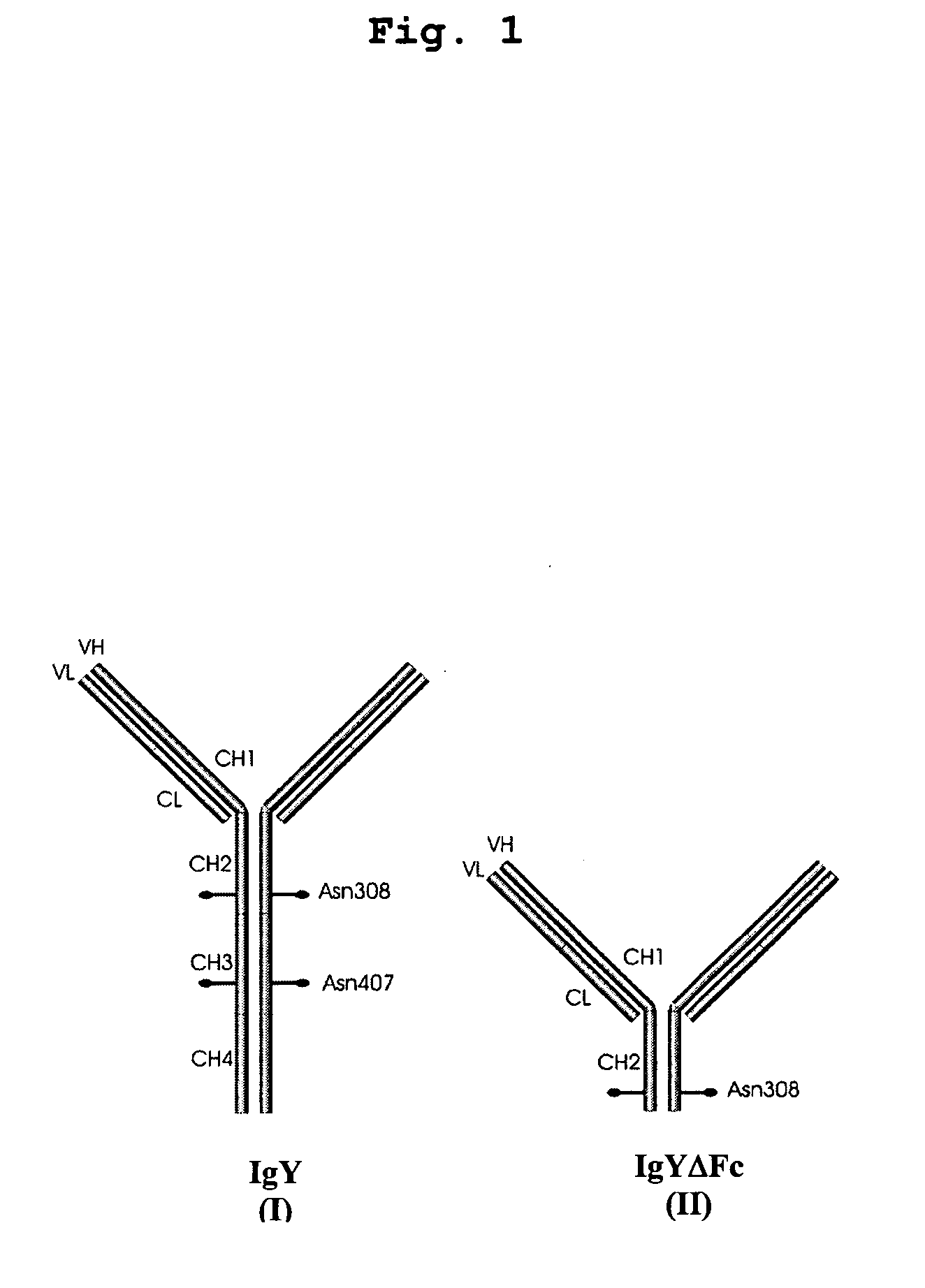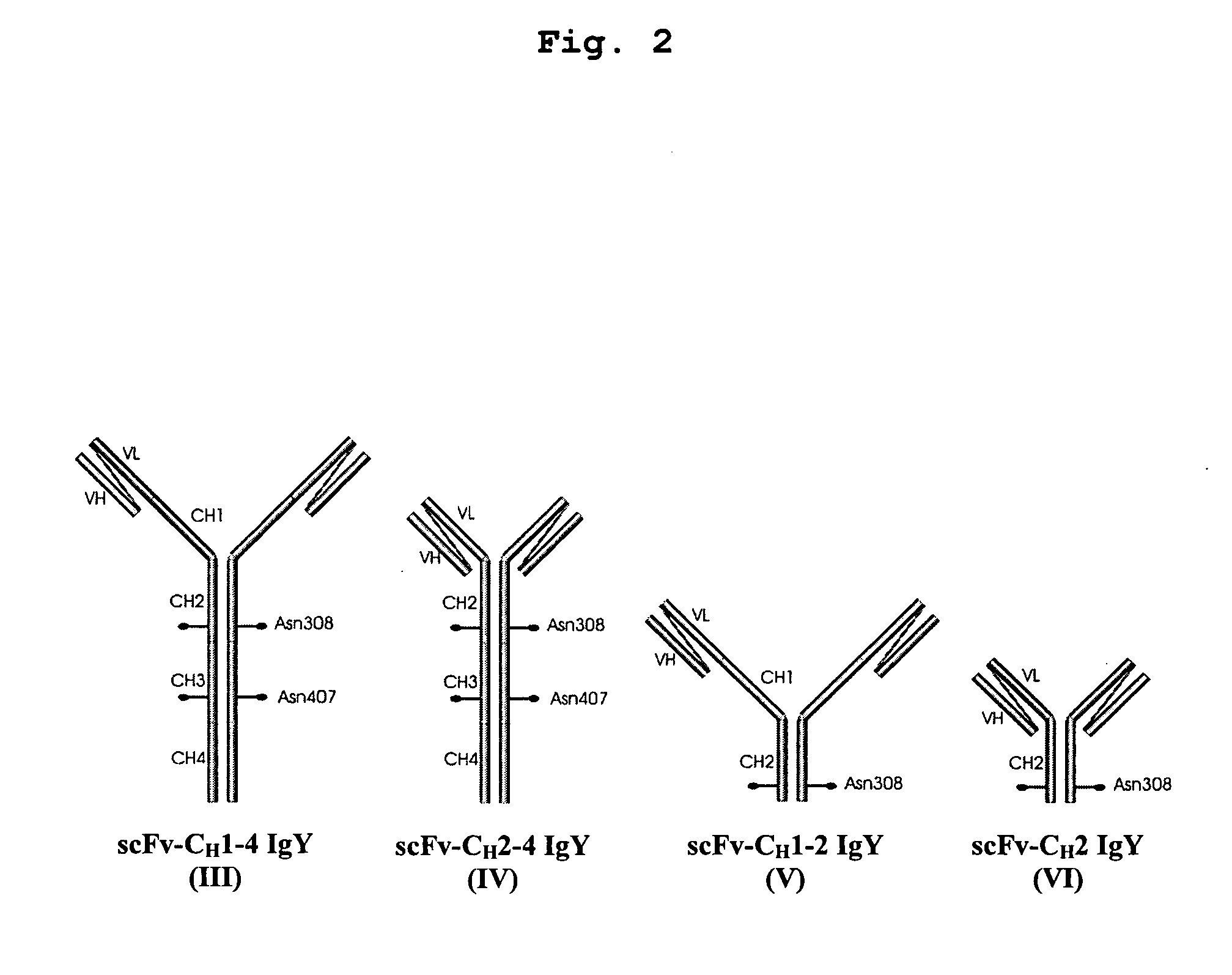Bivalent IgY antibody constructs for diagnostic and therapeutic applications
a technology of antibody constructs and constructs, which is applied in the field of bivalent igy antibody constructs for diagnostic and therapeutic applications, can solve the problems of increasing rf and hama interference, affecting the reliability and affecting the use of such antibodies in practice, so as to improve the content of stabilizing -structures, improve the resistance to denaturing agents, and improve the degree of reliability. the effect of diagnostic assay procedures
- Summary
- Abstract
- Description
- Claims
- Application Information
AI Technical Summary
Benefits of technology
Problems solved by technology
Method used
Image
Examples
example 1
Amplification and Cloning of IgY Constructs
1.1 Amplification and Cloning of Entire Avian Heterotetrameric antibody constructs.
[0097] For convenient expression of heterotetrameric antibody constructs, a set of modular cassettes was generated. Expression of the heterotetrameric IgY was achieved by inserting the IgY heavy chain and the λ light chain domains simultaneously into the mammalian expression vector pBudCE4.1 (Invitrogen life technologies, Karlsruhe, Germany). Expression of the heterotetrameric IgYΔFc was achieved by inserting the υCH1-2 domains and the λ light chain domains simultaneously into the mammalian expression vector pBudCE4.1 (Invitrogen life technologies, Karlsruhe, Germany). Coexpression of heavy and light chains is driven by strong CMV and EF-1α promoters.
[0098] Experimental methods can be carried out following standard methods well known in the art (e.g., Sambrook J, Fritsch E F, Maniatis T. Molecular Cloning. A Laboratory Manual, second ed., Cold Spring Harb...
example 2
Expression and Purification of Antibody Constructs
[0114] For expression of the individual antibody constructs HEK-293 cells (ATCC number CRL-1573) were cultivated in DMEM supplemented with 10% (v / v) heat-inactivated fetal calf serum, 100 IU / ml penicillin, and 100 μg / ml streptomycin. Tissue culture reagents were obtained from Invitrogen life technologies (Karlsruhe, Germany). HEK-293 cells growing in DMEM supplemented with 10% (v / v) fetal calf serum were transfected with 2 μg of the particular expression vector using jetPEI (Qbiogene, Irvine, USA). Stable transfectants then were selected in DMEM supplemented with 10% (v / v) fetal calf serum and 100 μg / ml of zeocin (Invitrogen life technologies, Karlsruhe, Germany).
[0115] For protein expression, transfected cells were grown for 3 days as an adhesion culture. The immunoglobulins secreted by transfected HEK-293 cells were purified from the culture medium by affinity chromatography using lysozyme immobilized onto NHS-activated sepharose...
example 3
Immunoreactivity of Antibody Constructs
3.1. Immunoreactivity of the Anti-Hen Egg Lysozyme IgY Constructs
[0116] For assessment of immunoreactivity of the anti-hen egg lysozyme constructs purified recombinant proteins (diluted with PBS-milk powder (PBS (2,7 M NaCl, 54 mM KCl, 87 mM Na2HPO4x2H2O, 30 mM KH2PO4), 2% (w / v) milk powder, MPBS) were applied to microtiter plates coated with lysozyme (50 μl per well, 100 μg / ml, Sigma, Taufenstein, Germany) at 4° C. overnight and blocked with MPBS at room temperature for 2 h. After incubation of the microtiter plates for 90 min at room temperature on a rocker platform, the wells were rinsed 3 times each with PBS-Tween (0.1% v / v Tween, TPBS) and PBS and further incubated with 100 μl each of an anti-chicken IgY-HRP (Horseradishperoxidase) conjugate (diluted 1: 5000 in 2% (w / v) MPBS, Sigma, Taufenstein, Germany) for 60 min at room temperature on a rocker platform. The wells were rinsed again 3 times each with 0.1% (v / v) TPBS and PBS and bound a...
PUM
| Property | Measurement | Unit |
|---|---|---|
| molecular mass | aaaaa | aaaaa |
| molecular mass | aaaaa | aaaaa |
| Mass | aaaaa | aaaaa |
Abstract
Description
Claims
Application Information
 Login to View More
Login to View More - R&D
- Intellectual Property
- Life Sciences
- Materials
- Tech Scout
- Unparalleled Data Quality
- Higher Quality Content
- 60% Fewer Hallucinations
Browse by: Latest US Patents, China's latest patents, Technical Efficacy Thesaurus, Application Domain, Technology Topic, Popular Technical Reports.
© 2025 PatSnap. All rights reserved.Legal|Privacy policy|Modern Slavery Act Transparency Statement|Sitemap|About US| Contact US: help@patsnap.com



